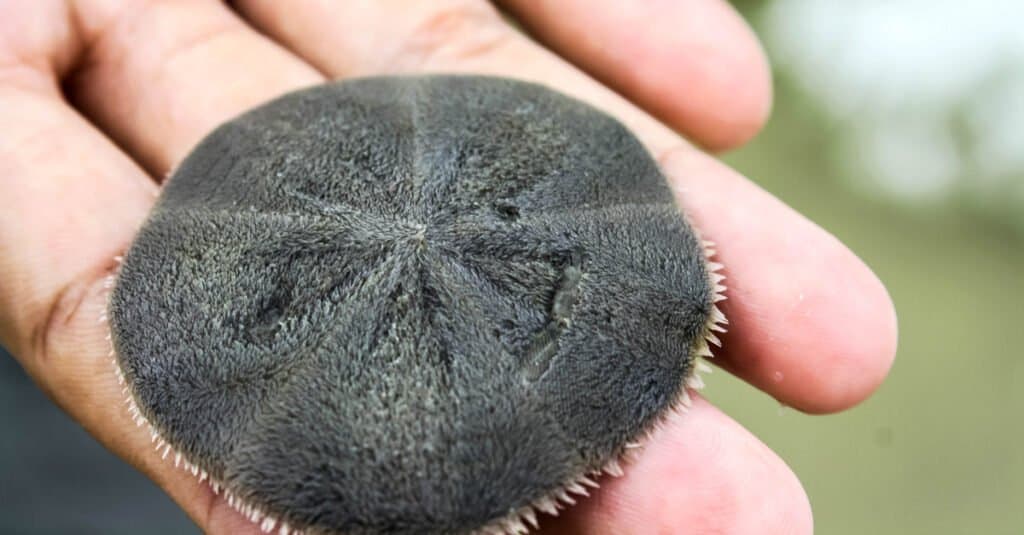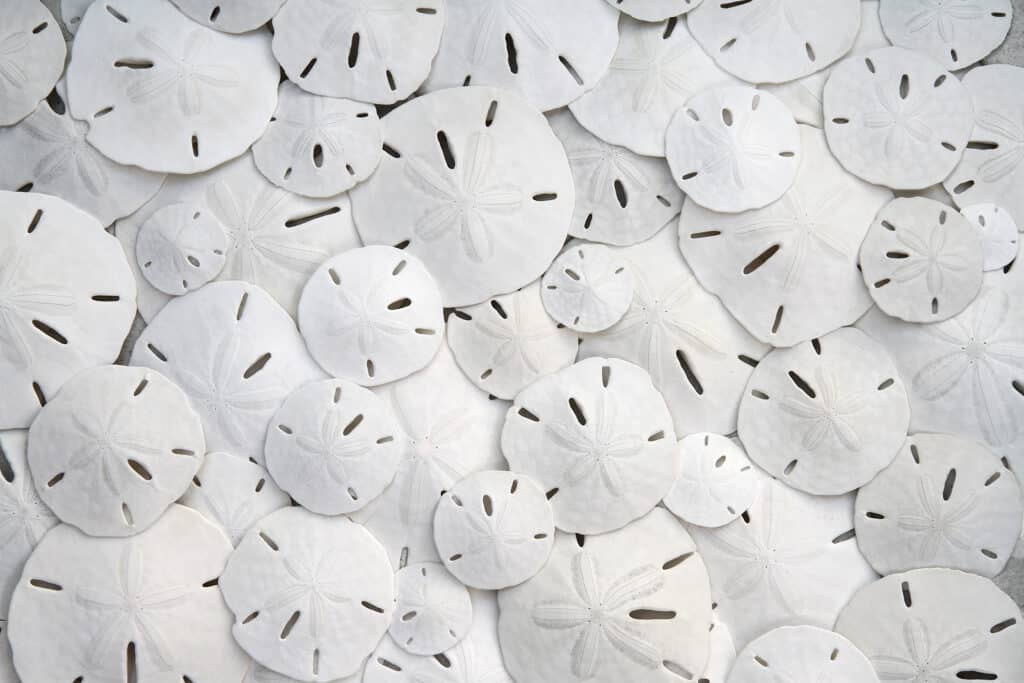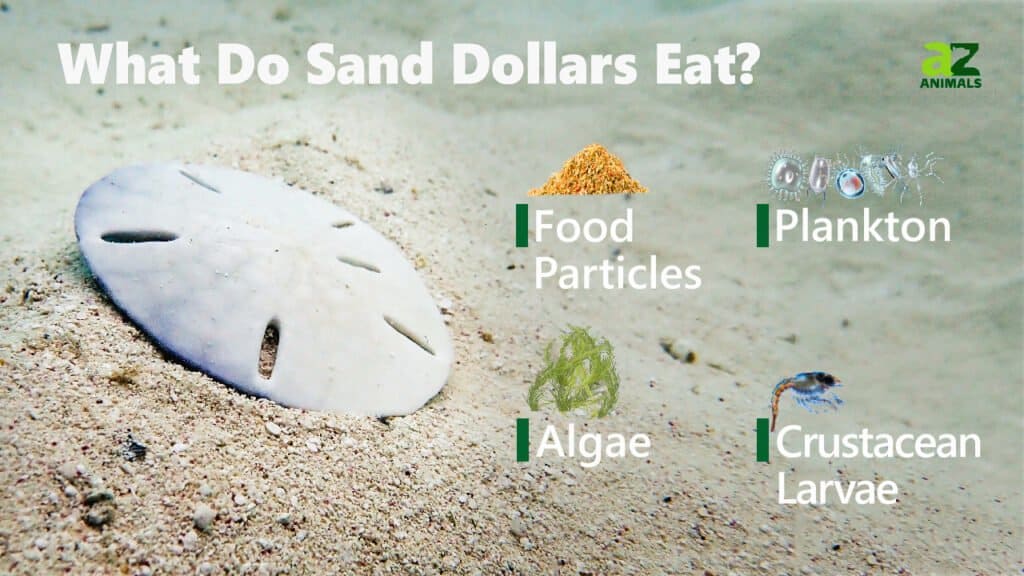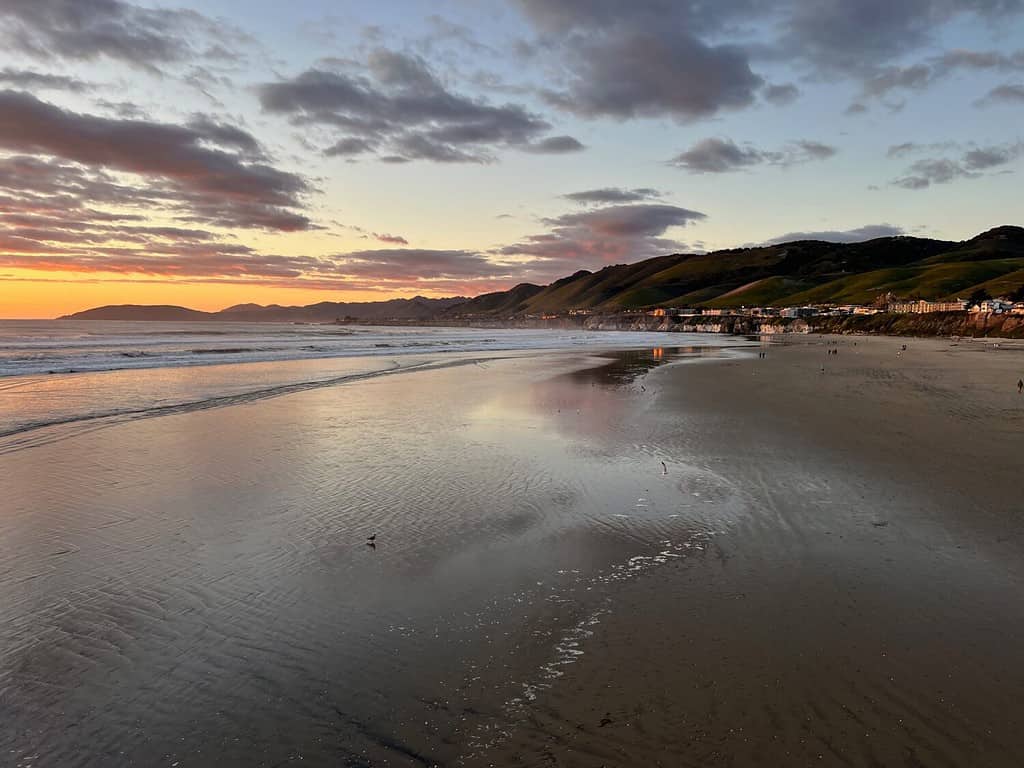The enchanting shores of Destin, known for their pristine beaches and tranquil jewel-toned waves, are the home of a remarkable discovery—the world’s largest sand dollar! In an exciting twist of fate in September of 2022, local beacher Blake Dumas stumbled upon this incredible find, measuring a staggering 6.5 inches in diameter and weighing an impressive 4.1 ounces. Blake uncovered this monumental sand dollar at the SWARA Dolphin Reef, nestled near the Pompano Joe’s Beach Access in the picturesque Miramar Beach.

In an exciting twist of fate in September of 2022, local beacher Blake Dumas stumbled upon this incredible find, measuring a staggering 6.5 inches in diameter and weighing an impressive 4.1 ounces.
©Megapixel/Shutterstock.com
After the find, Blake contacted Guinness World Records, and all signs pointed to Dumas’ sand dollar, shattering the record for the largest sand dollar ever found. The previous titleholder, with dimensions of 5.826 inches at its smallest diameter and 6.299 inches at its most significant, may soon be overshadowed by this magnificent coastal treasure.
Sand Dollar Hunting

It’s essential to remember that living sand dollars exhibit a brownish hue and should be treated with care, as they play a vital role in the local ecosystem.
©k_lmnop/Shutterstock.com
Sand dollars, a familiar sight for those vacationing in Destin, are relatively common along the coastline. Visitors are encouraged to keep their eyes peeled for these fascinating creatures while strolling the sun-kissed shores. It’s essential to remember that living sand dollars exhibit a brownish hue and should be treated with care, as they play a vital role in the local ecosystem. Disturbing or removing living sand dollars from the beach can have adverse effects, so observing them in their natural habitat is the responsible and eco-conscious choice.
However, the bleached skeletons of sand dollars make excellent souvenirs for those seeking a memorable keepsake of their Florida vacation. If you’re keen on collecting sand dollars, the best spots to find them are along the beach shore or near the second sandbar. Those along the coast are typically sand dollar skeletons, making them suitable for keepsakes.

Sand Dollars are very popular among sea shell collectors.
©Jillian Cain Photography/Shutterstock.com
To increase your chances of spotting these captivating creatures, consider exploring the beach coastline during the early morning hours when the tide is low, and fewer people are around. This reasonable time allows for a more peaceful and rewarding search.
For those eager to witness live sand dollars in their natural habitat, visiting the Gulf’s second sandbar, situated approximately 500 feet from the shore, promises an unforgettable experience. With snorkel gear and a paddleboard, embark on an underwater adventure to explore the wonders hidden beneath the waves.
How To Find Sand Dollars
Finding sand dollars can be an exciting and rewarding experience. Here are some tips on how to find sand dollars:
Choose the Right Time and Place: Visit the beach during low tide, when sand dollars are more exposed and accessible. Look for sandy, shallow areas, as they are the preferred habitat for these sea creatures.
Scan the Sand: Keep a keen eye on the sand as you walk along the shore. Sand dollars bury themselves in the sand, so watching for their circular shape and distinctive markings is essential. They may appear smooth, round, or slightly oblong patches on the sand.
Wade into the Water: To increase your chances of finding sand dollars, wade into the shallow waters near the shoreline. Be careful not to disturb the sandy bottom too much, as sand dollars can be delicate.
Be Gentle: When you spot a sand dollar, handle it with care. These creatures are often fragile, and even slight pressure can damage them. If you want to take a dollar home as a keepsake, opt for those already bleached and lifeless.
Check Tide Pools: Tide pools are excellent spots to find treasures and other marine life. Look for them in shallow pools created by receding tides.
More Tips
Use Polarized Sunglasses: Polarized sunglasses can help you see through the water’s surface, making it easier to spot sand dollars beneath the waves.
Observe Local Regulations: Before collecting dollars or marine life, ensure you are not violating local regulations or conservation efforts. Some areas may have restrictions to protect the ecosystem.
Respect Living Sand Dollars: If you come across living sand dollars, avoid touching or moving them. Living dollars have a brownish color and delicate hair-like structures covering their body. They are crucial to the marine ecosystem and should be left undisturbed.
Avoid Heavy Foot Traffic Areas: These creatures are more likely to be found in less crowded beach areas, away from heavy foot traffic. Explore quieter stretches of shoreline for a better chance of discovery.
Patience and Persistence: Finding sand dollars can require patience and persistence. Keep searching, and the beach will reward you with the sight of these unique and beautiful marine creatures.
Sand Dollar Fun Facts

The cilia that help the sand dollar move are visible in this photo.
©Lavendulan/Shutterstock.com
Not a Dollar: Despite their name, sand dollars are not a currency. They earned their name due to their flat, round shape resembling old Spanish or American silver dollar coins.
Echinoderms: Sand dollars belong to the echinoderm family, which includes sea stars, sea urchins, and sea cucumbers. They are close relatives of these sea creatures.
Endoskeleton: They have an internal support structure of calcium carbonate plates. This skeleton is responsible for their unique appearance and gives them a rigid, flat shape.
Burrowing Ability: They are skilled burrowers. Using their velvety spines, they dig into the sand, leaving a pattern of star-shaped trails on the ocean floor. This behavior helps them find protection and access food.
Live on Sandy Ocean Floors: They prefer sandy ocean floors, often in shallow waters near the shoreline. They bury themselves in the sand to protect themselves from predators and rough waves.
Oral and Aboral Side: They have two distinct sides: the oral side, which has a small mouth and is the underside where the spine sits, and the aboral side, which is the top side and appears flat and smooth.
Feeding Habits: They are filter feeders. They use their spines to create a current, bringing plankton and other tiny food particles toward their mouth. Once the food reaches their mouth, small hair-like structures called cilia help move the food particles to their digestive system.
Tube Feet: Like other echinoderms, they have tube feet. These tube feet are part of their water vascular system, which helps them move and assists in respiration and feeding.
More Fun Facts
Living Sand Dollars Look Different: When alive, these creatures have a velvety or fuzzy appearance due to their spines and small, moving cilia. They are often a greenish or brownish color. Once they die, the sun and ocean water bleach their endoskeleton, giving them the familiar white color we usually associate with sand dollars.
Reproduction: These creatures have separate genders, and they release eggs and sperm into the water for external fertilization. After fertilization, larvae develop and eventually settle on the ocean floor to grow into adults.
Natural Predators: Sand dollars face threats from predators such as sea stars, crabs, and certain fish species. Seagulls and other shorebirds also feed on sand dollar larvae.
Regeneration: They have the incredible ability to regenerate lost body parts. If predators break off one of their spines or damage their bodies, they can restore and replace the failed component.
Role in the Ecosystem
Sand dollars are crucial in the marine ecosystem, particularly in sandy ocean floor environments. Their activities and presence contribute to the health and balance of the coastal ecosystem in several ways:
Detritus Feeders: Detritivores feed on organic debris and dead plant and animal matter accumulating on the ocean floor. By consuming decaying organic material, they help to clean and recycle nutrients within the ecosystem, making these nutrients available to other organisms in the food chain.
Stirring Sediments: Their burrowing behavior is vital in stirring and oxygenating sediments. As they move and feed, they create small currents in the sand, facilitating gas exchange and promoting microbial activity. This process is essential for maintaining a healthy and balanced sediment environment.
Habitat Engineering: The burrows created by dollars provide shelter for other tiny marine organisms. These caves can serve as hiding places for small crabs, worms, and other creatures seeking protection from predators or environmental stresses.
Food Source for Predators: These creatures serve as an essential food source for various predators, including certain species of sea stars, crabs, fish, and shorebirds. Their role as prey helps to maintain the balance within the coastal food web.

Continued Role in the Ecosystem
Beach Erosion Control: The presence of sand dollars and their activities can contribute to stabilizing sandy shorelines. Stirring the sediment and creating burrows help prevent excessive erosion caused by wave action and currents.
Indicator Species: The abundance and health of populations can provide valuable insights into the overall health of the coastal ecosystem. Environmental changes or disturbances may impact their people, making them valuable indicator species for scientists studying the impacts of climate change and human activities on marine ecosystems.
Nutrient Cycling: As these creatures consume organic debris and detritus, they release nutrients back into the water through their waste. These nutrients, such as nitrogen and phosphorus, are essential for marine plants and algae’s growth and productivity.
Overall, sand dollars are a keystone species in sandy ocean floor ecosystems. Their presence and activities influence the distribution and abundance of other organisms, contributing to these coastal environments’ overall biodiversity and ecological balance. Protecting and preserving sand dollar populations is essential for maintaining healthy and thriving marine ecosystems.
Best Places to Sand Dollar Hunt in the United States
Finding sand dollars in the United States can be an exciting beachcombing experience. Here are some of the best places along the U.S. coastline where you have a good chance of discovering sand dollars:
Cannon Beach, Oregon: This picturesque coastal town on the northern Oregon coast is famous for its sandy shores and abundant sand dollars. Head to Haystack Rock and the tide pools during low tide for the best chances of finding them.
Long Beach, Washington: Long Beach, located in the southwestern corner of Washington state, offers long stretches of sandy shoreline and is another excellent spot for sand dollar hunting.
Sanibel Island, Florida: Known as the “Seashell Capital of the World,” Sanibel Island on the Gulf Coast of Florida is a hotspot for finding sand dollars and a variety of other seashells.
Monterey Bay, California: The beaches around Monterey Bay, including Asilomar State Beach and Pacific Grove, are popular destinations for sand dollar collectors.
Pismo Beach, California: Located on California’s Central Coast, Pismo Beach is a great place to search for sand dollars, especially during low tide.

Pismo Beach is a great place to search for sand dollars, especially during low tide.
©fivetonine/Shutterstock.com
Ocracoke Island, North Carolina: This barrier island on the Outer Banks of North Carolina is known for its beautiful beaches and plentiful finds.
More Places to Find Sand Dollars
Hilton Head Island, South Carolina: Hilton Head Island’s sandy shores along the Atlantic coast can yield dollars, especially in more secluded areas.
Assateague Island, Maryland, and Virginia: Assateague Island, known for its wild horses, is a unique location to find sand dollars along its sandy beaches.
Galveston Island, Texas: The beaches of Galveston Island on the Gulf of Mexico offer opportunities to find dollars, particularly after a storm.
Blake Dumas’ name is etched into the coastal lore as the excitement over this extraordinary discovery. It continues to ripple through the Destin community. It’s the allure of the world’s most significant dollars or the breathtaking charm of the Emerald Coast itself. One thing remains certain—Destin never fails to deliver something extraordinary to its visitors. So, the next time you stroll along these magnificent beaches, watch for the wonders beneath the surface. You might uncover your treasure.
The photo featured at the top of this post is © A-Z-Animals.com/N/A
Thank you for reading! Have some feedback for us? Contact the AZ Animals editorial team.






